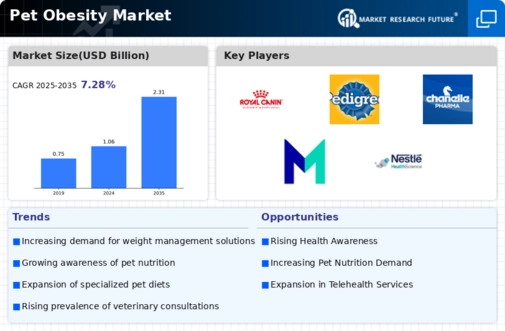Market Trends
Key Emerging Trends in the Pet Obesity Market
The increasing public concern for the welfare of pets has led to notable trends in the Pet Obesity Market. This market aims at curbing pet obesity, a growing concern that results from the increase in pet ownership and changing lifestyles. Among the various factors such as nutrition, exercise and health care practices several key trends have appeared in the Pet Obesity Market.
One important trend in this market is increased awareness about health dangers related to pet obesity. The owners of pets are now aware that excessive weight poses risks to their animals and therefore they are enrolling them into different preventive measures and treatment options. As more people understand about matters pertaining to obesity among pets, there is more emphasis on preventive measures such as proper nutrition, regular physical activities and veterinary check-ups focusing on weight control and general wellness.
Moreover, there is a change of formulations for pet food in order to make it specialized nutritionally balanced diets are being sought after by consumers who also seek high-quality commercial brands with weight management features for their overweight or obese animals. Additionally, this trend relates to a more widespread awareness regarding diet’s role, which leads pet food manufactures into innovating ways of developing products that meet nutritional needs of animals at risk of becoming obese.
Furthermore, technological improvements have impacted the Pet Obesity Market by bringing wearable gadgets and smart technologies aimed at tracking activity levels together with overall well-being among other things. These devices enable pet owners to monitor how often their pets move around, how many calories they burn each day or even track them down if they get lost somewhere outside home through real-time data feedback systems established on these devices. The employment of technology in animal health care also helps identify excess body fat early enough as well as promoting proactivity among owners towards nurturing healthy pets.
There has been an increase in development of weight loss supplements and drugs specific for companion animals within Pet Obesity Market. In addition to helping cut down weight these commodities help maintain good health thereby giving pet owners an additional means of addressing obesity-related issues. As such, vets are more frequently including supplements in their patients’ weight management regimens, for holistic animal health by good nutrition, exercise and supplementation where necessary.
At the same time, this market is witnessing collaboration between pet owners, veterinarians and other pet care providers to combat pet obesity. This includes campaigns that raise awareness, education and community programs which address pet owners about the dangers of obesity while promoting healthy lifestyles for pets as well as regular visits to a doctor’s office to check the weight. The cooperative approach intends to create conducive conditions for Pet Owners so that they can understand choices on what their animals should eat for proper well-being.
Nevertheless, Pet Obesity Market still struggles with some challenges. Some of these include noncompliance by pet owners, misconceptions about ideal body condition of animals and constant availability of high-calorie treats. Moreover, there are different types of pets suffering from obesity epidemic i.e., dogs; cats; small mammals which have different dietary requirements and lifestyle patterns thus making it hard for the market to address them all at once.









Leave a Comment